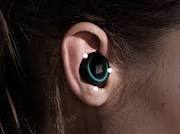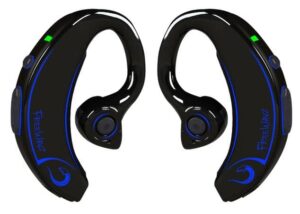Ear-level electronic devices are on shifting ground. FDA aside, what defines a “hearing aid” these days? They are sophisticated, computer-based, ear-level, binaural, Bluetooth-enabled devices with storage and automatic programming capability. They’re poised for far more than amplification, noise reduction, and feedback control.
If you accept that functional definition of today’s hearing aids, what’s left to define a Hearable? Is it every ear-level gadget except a hearing aid, or are hearing aids the high end of the Hearable armamentarium? If the latter, does that turn hearing aids into gadgets? Where do PSAPs fit in?
To bring definitions full circle, whatis.com defines Hearables in a way that sounds like a hearing aid to this reader:
Hearables are wireless wearable computing earpieces that enable voice input and return results audibly to the user’s ear.
What, Exactly, Are We Talking About?
We’re talking about a lot more than a PSAP, which itself has been hard enough to define. Hearables have the potential to be whatever you want them to be, in which case one can make the argument that if it sits at, on, in, hangs on, or maybe even hovers by your ear, it’s a Hearable. What consumers want will depend on the state of their hearing ability, changing acoustic environments, physical state, real-time goals, real-world activities and location, and cost of content.
Besides solving hearing problems or enhancing normal hearing, Hearables are poised for eventual seamless connectivity with the fabled Internet of Things (e.g., phones, people, dogs, your keys, computers, your stove), enabling wearers to define their own personal area networks. They will stream content of your choice (e.g., books, courses, music, movies, events); manipulate noise and perform voice identification. Some will connect wirelessly to body monitors; others will function as their own body monitors by virtue of embedded electronics (e.g., accelerometers, micro-thermistors).
Here’s a sampling of Hearable-related endeavors currently on the drawing board or in the works, in addition to 2014 devices (e.g., Soundhawk Smart Listening System) that were covered in previous posts. They come from developers/manufacturers with varied backgrounds, intentions, funding, and experience with the hearing aid industry.
- ReSound’s “Smart hearing solutions,” LiNX, LiNX TS, and ENZO, were showcased at 2015 CES 2015 with new Android platform capabilities. Siemens’ Smart Hearing Aid receied special notice as a “cool new” wearable at the show.
- Adnan Shennib’s iHear Medical device is not a PSAP, but a “web enabled hearing aid” that is still in the investigational stage but is already getting awarded patents.1 It will use online test and fitting protocols, all wirelessly via a kidney-bean sized in-canal instrument. Whether it’s a hearing aid or a merging hearing aid Hearable is up to the user, I’d guess. iHear Medical started as a crowd-sourced device on indiegogo, but recently got a $5M cash infusion from venture capital financing to continue its development. No word on when it will come to market.
- Plantronics, Inc.’s patent #US8503689 B2 describes a control box that functions as both a radio transmitter and receiver, able to send signals to and from the ear.
- Sony’s next-generation Ultra-miniature Bluetooth modules, currently under development, will fit into small, inexpensive, user-controlled headsets “without the need for any other processor.”
- Patent application #789531 (no assignee) describes an earphone controller in the form of “a cellular telephone [embodied in]… a unitary housing having a speaker engaging the user’s ear canal. … A boom extends from the housing, and has a distal end extending toward the user’s mouth.”
- Bragi‘s Dash earbuds, are another crowd-sourced invention, which the developers have proclaimed the “World’s First Hearable.” Currently available for pre-order ($299) and set to launch in April 2015, the website claims are impressive:
“the world’s first wireless smart ear headphone: Wireless in ear headphones. 4GB MP3 Player Microphone Bluetooth headset Fitness Tracker Heartrate Monitor Waterproof. No cables. Standalone & phone. Wearing comfort & secure fit. Touch sensitive control at the tip of your finger. Charge anywhere in less than 1 hour.”
Bragi’s claims keep growing as new concept applications crop up. At the 2015 CES show, the Dash was touted as responsive to directional head nods to check the weather, move things, etc. It’s going to be waterproof. All this with just $3M raised by crowd funding. Whether it actually launches in April and whether it lives up to expectations and claims remains to be seen, but it surely gives an idea of what’s in store for ears in the future. It also moves Hearables away from smartphone control and toward ear-level autonomy.
- Intel’s body-monitoring earbuds made Wired’s list of 10 Best Gadgets at CES 2015. They’re not wireless and they won’t be sold by Intel, which has yet to announce its partner for this endeavor. Wired like them because:
[the] “tracker inside that syncs to both iOS and Android phones. It collects calorie, pace, distance, and time data. But more importantly, it tracks your heartbeat in real time and offers a visible history graph on your phone’s screen. Plus, if you’re falling below or going above your target heart rate, the system automatically plays a song to pump you up or calm you down.”
- BioSensive Technologies’ Ear-O-Smart is a crowd-funded, wireless Bluetooth fitness earring due out in May 2015. As a wearable, ear-level processor, Ear-O-Smart pushes the definition of Hearables because nothing is heard. If it comes to market and finds a market, it could morph into a Hearable. Nevertheless, it is one of the few ear-level fashion Wearables.
-
FreeWavz Smart Earphones are wireless, content-streaming, audio-enhancing, fitness-monitoring, app-driven gadgets that look a lot like retro BTEs attached to earpods (Fig 1). Furthermore, even though they’re not called hearing aids, they act like hearing aids or PSAPs: according to a CES review. They will sync binaurally, “compensate” for hearing deficits, allow customization for “environmental audio pass-through,” and use multiple mics for noise reduction. FreeWavz, too, are a crowd-funded idea with a projected March, 2015, fullfillment date.
- Nanoplug is another crowd-sourced device that does call itself a hearing aid. It distinguishes itself with a “nano-battery” that recharges “almost instantaneously” and makes the device very small. The website describes it as The World’s First Invisible Hearing Aid and the most recent production update says it may be available for sale in March as a self-programmable device. It does not appear to have gone through FDA approval, despite calling itself a hearing aid.2 Of interest was a review on a (currently-enactive) website called 800whistleblower, which suggested crowd sourcing as a possible work-around to FDA requirements:
Accessing hearing aids via social funding platforms may be the best approach for those who simply can’t afford the average Food and Drug Administration-approved hearing aids that cost upwards of $2,000 apiece.
Who’s In Charge?
FDA Rules and Regulations make it unlikely that Nanoplug can sell hearing aids stateside by simply offering them over the Internet, regardless of what 800Whistleblower opined. On the other hand, PSAPs made their way around the FDA and sell with little hindrance or scrutiny, leaving plenty of room for hearing aids that call themselves earphones to sell direct to consumers.
What with shifting, merging sands of hearing aids and Hearables, who’s to say what groups get to decide what devices belong to which camps: the FDA, CEA, Google and Apple, audiologists, consumers? Who gets final say on who sells them and how they are sold? Ultimately, will hearing aids morph into consumer electronic gadgets? More on that in upcoming posts.
This is the 3rd post in the Hearable series. Click here for post 1 or post 2.
References and Footnotes
1WIPO publication Numbers WO/2015/009561, WO/2015/009559, and WO/2015/009569 were awarded on Jan. 22 to iHear Medical Inc. (US) for inventions entitled “HEARING AID FITTING SYSTEMS AND METHODS USING SOUND SEGMENTS REPRESENTING RELEVANT SOUNDSCAPE,” “HEARING PROFILE TEST SYSTEM AND METHOD,” and “INTERACTIVE HEARING AID FITTING SYSTEM AND METHODS.” Inventor is Adnan Shennib.
2Update: Nanoplug never seems to have made it off the drawing board, perhaps illustrating the gigantic gap between idea and realization, certainly illustrating the gap between funding and fruition.
Feature image courtesy of Bragi. Fig 1 courtesy of FreeWavz.








Great post Holly. For some of my reflection on this very topic check out:
https://www.hearingtracker.com/blog/soundhawk-review-hearing-loss-expert-analysis/
Thank you for the link, which provides a good deal of technical information. Psychometrics would be a next good step to take, since monaural hearing is not ideal for hearing aid fittings but is the only approach available (I think) with Soundhawk. Next up would be the all-important comfort issue, which I have yet to see addressed in the literature in a study that compares hearing aids versus modular units such as Soundhawk. Looking forward to those!
Great article that points out what I’ve been writing about for years.
As the gear we use continues to evolve it becomes ever more apparent that hearing aids, as we’ve known them are a thing of the past.
Today’s digital gear not only goes far beyond what the regulations envisioned when written, but continues to evolve ever greater and greater capabilities with each successive chip set developed.
To continue to believe that the gear we use will remain within the protected and highly regulated realm of a hearing aid, is to deny the all of the evidence that surrounds us.
That any group continues to believe that they can control the how, and from whom the acoustic devices that are worn at ear level, and capable of amplifying sounds in a specific way is, or should remain solely within the Audiological, or licensed community is deluding themselves.
The simple fact that our current delivery system only reaches approximately 20% of those who could benefit from these devices clearly indicates why Smith’s invisible hand is reshaping what was exclusively our protected market.
Believing any of us can remain hidden behind an education, or license without providing real value to the consumers in exchange for the products, and services we would provide is pure fantasy.
The sooner we recognize this, and respond, rather than reacting as though we could continue to control the who’s, what’s, and where’s of consumer activity, the sooner we’ll begin to reach beyond the 20% market penetration we’ve achieved through the current highly controlled and regulated hearing aid delivery system.